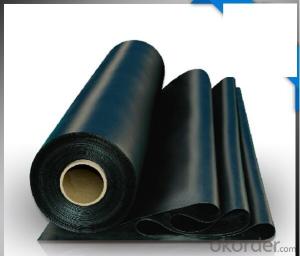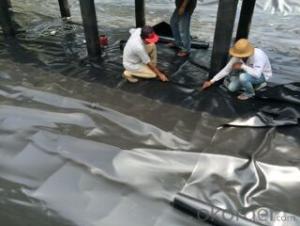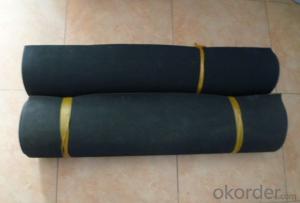EPDM waterproof membrane for roof basement and pond
- Loading Port:
- Qingdao
- Payment Terms:
- TT OR LC
- Min Order Qty:
- 1000 m²
- Supply Capability:
- 100000 m²/month
OKorder Service Pledge
OKorder Financial Service
You Might Also Like
EPDM Coiled Rubber Waterproof Membrane for Ponds
Descriptions for EPDM:
GeoGard EPDM offers dependable performance for irrigation reservoirs, canals, aquaculture, dung pits, landfill covers,
waste water reservoirs, constructed wetlands, artificial snow reservoirs, storm water reservoirs, fire reservoirs and
large decorative ponds.
Main Features of EPDM Rubber Waterproof Membrane:
Superior durability
Seamless sheets in 1 piece
Very low life-cycle cost
Flame-free and easy installation
High flexibility and elongation
Environmentally friendly
Recovery of rainwater
Fire resistance
Specifications of EPDM Rubber Waterproof Membrane:
Material | EPDM Rubber |
Size | 1.2m (width)*20m (length) or customized, weldable type 2.05m or 4m width |
Thick | 1.2mm, 1.5mm, 2.0mm |
Type | Vulcanized & Weldable |
Pattern | Non-reinforced (homogeneous) |
Certificate | ISO9001/14001 |
Applications of EPDM Rubber Waterproof Membrane:
1.Roofs, Basement, Toilets
2. Industrial and civil building waterproofing
3. Geosynthetic liner for swimming pool, channels, irrigation system
4. Especially suitable for projects with high requirements in durability, anti-corrosion and deformation.
Photo for EPDM Rubber Waterproof Membrane:
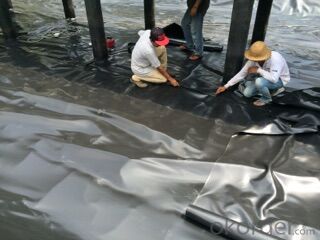



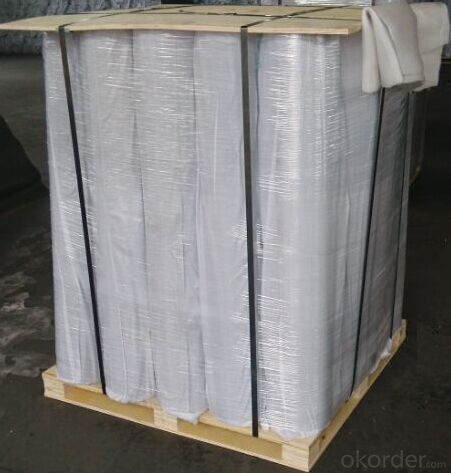
FAQ:
1. What are we supplying?
We are specialized in producing Colorful Asphalt Roof Shingle, SBS/APP modified bitumen waterproof membrane, Self adhesive bitumen waterproof membrane, PVC waterproofing membrane, EPDM rubber roofing membrane, Single Component Polyurethane Waterproof Coating, and Spray Polyurea Waterproof Coating
.
2. How Many years experience do we have?
We have been exported to more than 20 countries in the past 15 years.
3. How long do we usually reply your request?
We always reply our customer within 24 hours.
- Q:Can a waterproofing membrane be used for walkways or pedestrian bridges?
- Yes, a waterproofing membrane can be used for walkways or pedestrian bridges. Waterproofing membranes are designed to protect surfaces from water infiltration and can be applied to various structures, including walkways and pedestrian bridges, to prevent water damage and ensure their longevity.
- Q:Can a waterproofing membrane be used for a foundation?
- Indeed, a foundation can benefit from the utilization of a waterproofing membrane. This particular type of membrane serves the purpose of acting as a barrier against the infiltration of water, providing protection against moisture-related harm to the foundation. Typically composed of materials like bitumen, rubberized asphalt, or polymer-based sheets, these membranes are installed on the exterior aspect of the foundation walls. Their primary function is to impede the penetration of water into the foundation, thereby averting potential complications such as water damage, mold proliferation, and structural deterioration. It is of utmost importance to ascertain that the installation of the waterproofing membrane is executed accurately, adhering to the specific requirements of the foundation, in order to ensure its optimal efficacy.
- Q:Can a waterproofing membrane be used for a planter box waterproofing?
- Yes, a waterproofing membrane can be used for planter box waterproofing. A waterproofing membrane is designed to create a barrier against water and moisture, preventing it from seeping through the surface it is applied to. This makes it an ideal choice for planter box waterproofing, as it helps to protect the structure of the planter box and prevent water damage. The membrane can be applied to the interior of the box, creating a watertight seal that prevents water from leaking out or causing damage to the surrounding surfaces. Additionally, a waterproofing membrane can also help to extend the lifespan of the planter box by preventing the growth of mold or mildew, which can be caused by excess moisture. Overall, using a waterproofing membrane for planter box waterproofing is a practical and effective solution to ensure the longevity and durability of the planter box.
- Q:Are there any specific considerations for installing a waterproofing membrane on precast concrete surfaces?
- Installing a waterproofing membrane on precast concrete surfaces requires specific considerations. Here are some important points to remember: 1. Proper Surface Preparation: Before applying the waterproofing membrane, it is crucial to prepare the precast concrete surface correctly. This involves cleaning the surface, removing loose particles, and ensuring it is dry and free from any contaminants. 2. Compatibility: It is important to select a waterproofing membrane that is suitable for precast concrete surfaces. Some membranes may not adhere well or provide effective waterproofing on this type of substrate. Therefore, it is essential to choose a membrane specifically designed for use on precast concrete. 3. Ensuring Adhesion: Properly adhering the waterproofing membrane to the precast concrete surface is vital. It is important to carefully follow the manufacturer's instructions, including any surface priming or preparation requirements for optimal adhesion. Proper adhesion will prevent water infiltration and concrete damage. 4. Joint Treatment: Precast concrete surfaces often have joints between panels or components. These joints need proper treatment to maintain the system's waterproofing integrity. This may involve using joint sealants or tapes designed specifically for waterproofing purposes. 5. Considering Durability: Consider the durability and longevity of the waterproofing membrane. Precast concrete surfaces are exposed to various weather conditions and environmental factors. Therefore, it is crucial to choose a membrane that can withstand these conditions and provide long-term protection against water penetration. 6. Quality Assurance: It is recommended to work with experienced professionals or certified installers to ensure the proper installation of the waterproofing membrane on precast concrete surfaces. This minimizes the risk of installation errors and ensures that the waterproofing system performs as intended. By considering these factors, installing a waterproofing membrane on precast concrete surfaces can effectively protect the concrete from water damage and extend its lifespan.
- Q:Are waterproofing membranes suitable for bridge abutments?
- Yes, waterproofing membranes are suitable for bridge abutments. These membranes provide an effective barrier against water infiltration, protecting the abutments from moisture-related damages such as corrosion, deterioration, and leakage. They help extend the lifespan of the bridge and ensure its structural integrity.
- Q:Can a waterproofing membrane be used in conjunction with other waterproofing products?
- Indeed, when it comes to waterproofing, it is customary to employ various products in conjunction with a waterproofing membrane. This practice aims to offer heightened safeguarding against water-related harm. For instance, one may opt to utilize a waterproofing membrane as the primary layer of protection, which can then be complemented by additional products like sealants, coatings, or drainage systems to enhance durability and performance. By combining these products, a more resilient and all-encompassing waterproofing system can be achieved, effectively shielding against water infiltration and averting any potential leakage or moisture-related complications.
- Q:What is BSB waterproofing membrane
- ?Features: The coil has excellent high temperature resistance and can be used at -25 in the temperature range of + 100 ° C, with high elasticity and fatigue resistance, as well as up to 1500% elongation and strong puncture resistance , Tear-resistant cold. Suitable for cold areas, as well as deformation and vibration of large industrial and civil buildings waterproofing works. Low temperature flexibility is good, to -25 ℃ does not crack; high heat resistance 100 ℃ does not flow. Good extension performance, long service life, simple construction, small pollution and so on.
- Q:Can a waterproofing membrane be used on steel surfaces?
- Yes, a waterproofing membrane can be used on steel surfaces. Waterproofing membranes are designed to provide a protective barrier against water and moisture, and they can effectively adhere to and seal steel surfaces, preventing water penetration and potential damage.
- Q:Can waterproofing membranes be used on concrete floors?
- Indeed, concrete floors can benefit from the utilization of waterproofing membranes. Within construction, these membranes hold a prevalent role in averting water infiltration and safeguarding the underlying structure. By implementing them onto concrete floors, a protective barrier arises, effectively thwarting water from permeating and causing harm. Significantly beneficial, waterproofing membranes prove their worth in spaces prone to water exposure, such as basements, bathrooms, and outdoor patios. Their presence ensures the concrete floor's durability while defending against moisture-related predicaments like cracking, spalling, and mold development.
- Q:Are there any specific considerations for installing a waterproofing membrane on stucco surfaces?
- Installing a waterproofing membrane on stucco surfaces requires careful consideration. Firstly, the stucco surface must be thoroughly cleaned and free from any dirt, debris, or loose material. This can be achieved by either power washing or scrubbing the surface with a stiff brush and water. Secondly, it is crucial to select the appropriate waterproofing membrane for stucco surfaces. Various options are available, including liquid-applied membranes, sheet membranes, or peel-and-stick membranes. It is imperative to choose a membrane that is compatible with stucco and offers a strong and durable barrier against water penetration. Another aspect to consider is the proper application technique. The membrane should be evenly and smoothly applied to ensure complete coverage over the entire stucco surface. It is important to follow the manufacturer's instructions and guidelines for the specific membrane being used. Additionally, special attention should be given to details and transitions, such as areas around windows, doors, vents, or other penetrations. These vulnerable points are more prone to water infiltration, so it is essential to adequately seal and waterproof them using additional techniques or products, such as flashing or caulking. Furthermore, the climate and weather conditions in the area must be taken into account. If the stucco surface is exposed to extreme temperatures or frequent freeze-thaw cycles, it is advisable to choose a waterproofing membrane that can withstand these conditions and provide long-lasting protection. Lastly, regular inspection and maintenance of the waterproofing membrane are vital to ensure its effectiveness over time. It is recommended to periodically check for any signs of damage, such as cracking, peeling, or bubbling, and promptly address any issues to prevent water infiltration and potential damage to the stucco surface. In conclusion, when installing a waterproofing membrane on stucco surfaces, it is necessary to clean the surface, select the appropriate membrane, apply it correctly, pay attention to details and transitions, consider the climate, and regularly inspect and maintain the membrane for long-term protection against water penetration.
1. Manufacturer Overview |
|
|---|---|
| Location | |
| Year Established | |
| Annual Output Value | |
| Main Markets | |
| Company Certifications | |
2. Manufacturer Certificates |
|
|---|---|
| a) Certification Name | |
| Range | |
| Reference | |
| Validity Period | |
3. Manufacturer Capability |
|
|---|---|
| a)Trade Capacity | |
| Nearest Port | |
| Export Percentage | |
| No.of Employees in Trade Department | |
| Language Spoken: | |
| b)Factory Information | |
| Factory Size: | |
| No. of Production Lines | |
| Contract Manufacturing | |
| Product Price Range | |
Send your message to us
EPDM waterproof membrane for roof basement and pond
- Loading Port:
- Qingdao
- Payment Terms:
- TT OR LC
- Min Order Qty:
- 1000 m²
- Supply Capability:
- 100000 m²/month
OKorder Service Pledge
OKorder Financial Service
Similar products
New products
Hot products
Hot Searches
Related keywords
